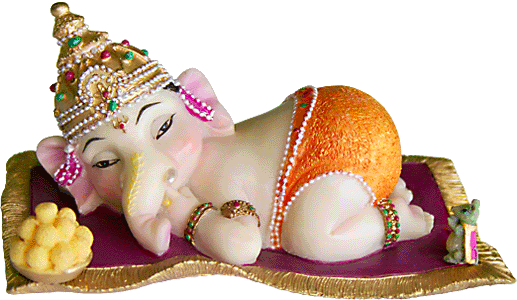
The delightful Ganesh, the god of new beginnings, wisdom and education is the most cherished and well regarded of all Hindu deities. His name and iconography have spread far beyond India and Ganesh is widely known and loved throughout the world
lord ganesh
hinduism
Hinduism, Jainism and Buddhism have many sects and widely differing beliefs, philosophies and theologies, however Ganesh is the only deity that is loved, worshipped and adored throughout all these faiths and his worship is universal in India and in many other places all over the world. A large part of Hinduism considers Ganesh to be of the five prime divine deities together with Brahma, Vishnu, Durga and Shiva.
origins
Ganesh is the son of a great mother the Goddess Parvati, and a magnificent father, the Lord Shiva. There are differing legends concerning his birth or creation and his original and subsequent forms. The name Ganesh mean Lord of the Gunas, Guna meaning groups or community. Ganesh has a human pot bely, with the ears and trunk of an elephant. He is believed to have cut off one of his tusks, so he would have a suitable implement with which to write the Mahabharata.
worship
Ganesh, the bestower of prosperity and protection is the most regularly worshipped deity in India and all HIndus homes will have a idol of Ganesh, which is revered and venerated. Ganesh is also present in his role as a protector at the doorways and entrances to temples homes. Ganesh removes obstacles as well as placing them and ensures good luck as well as making sure that bad luck stays away.
traits
Ganesh is the master of Buddhi which means Intellect. The wives of Ganesh are Siddhi, the bestower of spiritual power and Riddhi, the bestower of prosperity Ganesh has two sons Labh, meaning profit and Subh, meaning auspicious. Ganesh is venerated as the remover of spiritual and material obstacles and he is the patron of the arts and sciences, intellect and wisdom. In his role as the god of new beginnings Ganesh is invariably called upon and worshipped at the start of any hindu rituals and ceremonies, including weddings
attributes
In order to teach lessons and remove ignorance. Ganesh silently and in devotion listens to what we say and the prayers that we utter, and then passes them on to the relevant deities. He has ears to enable him to hear well, and he is instrumental in removing fears and doubts. Elephants are known to have great listening ability and exceptional memories. Allowing for body size elephant have some of the largest brains on the planet. Ganesh is an evolving deity and his attributes change from time to time and place to place, such flexibility being his whole attraction.
mounts
Naturally such a deity has to have several suitable mounts and like many hindu deities, Ganesh has mounts which would be the envy of many fancy vehicle worshippers around the world. Ganesh strides on top of the most humblest of creatures, a tiny mouse, signifying his lack of prejudice between the great and the not so great. The mouse being a creature which is able to access the most secret of places this mount signifies the attribute of the all knowing Ganesh. You will also find Ganesh riding magnificently upon a proud peacock showing his triumph over pride and proudness and his mastery over beauty and prominence. Ganesh has other mounts as well including a lion, a serpent, a horse as well as other animals.
scrivener
The sage Ved Vyasa, the composer of the hindu epic poem, the Mahabharata, recited the work to Ganesh and it is believed that Ganesh broke off part of one of his tusks so that he would have a suitable implement with which to write down the poetry and wisdom of the sage. His sacrifice of his tusk is a symbol of the sacrifices that writers and scholars make in their pursuit of knowledge and portrayal of their art. Ganesh is therefore invoked at the beginning of writing and learning sessions
festivals
Ganesh Chaturthi is a ten day festival which falls in late august early September. The festival is celebrated by clay idols and other representations of Ganesh being made and then venerated. These icons can be small from 6 inches to over 50 feet high. After veneration, the icons are immersed in a lake or body of water, after adding herbal and medicinal herbs and plants. The addition of these items was regarded as having purifying qualities such as kept the water suitable for drinking. The most elaborate festivities today take place in the Indian state of Maharashtra, where the iconography of Ganesh was used by nationalist leaders in 1893, to unite the people in strong solidarity against British rule. The festival today is a noisy, extravagant display of pomp and splendor with marching and music and chanting.
portrayals
Ganesh has been lovingly portrayed by artists and sculptors in many forms, you see him dancing, playing, lounging and battling. His statues will have many differing stances and props signifying differing symbolisms. Ganesh is an evolving god and his attributes change from time to time and place to place.
Given his association with good luck and prosperity, Ganesh became the principal deity associated with traders and his veneration and worship by merchants and traders led to his image being taken to many far off lands, such as Java, Bali, Borneo, Burma, Thailand, Indochina, Cambodia, Afghanistan, Tibet, China and Japan, with his shrines and temples arising all over Southeast Asia and elsewhere.
 |  |  |  |
|---|---|---|---|
 |  |  |  |
 |  |  |  |
